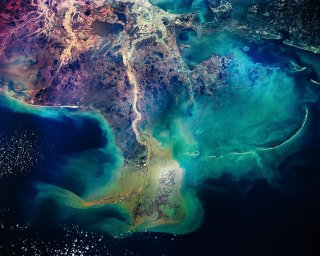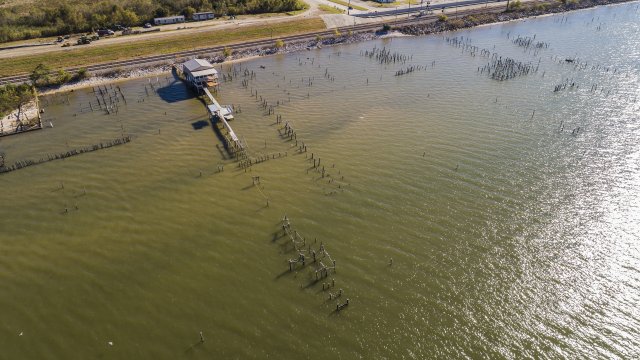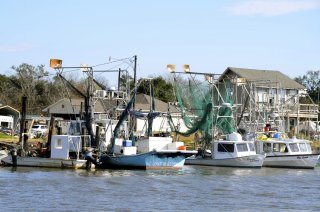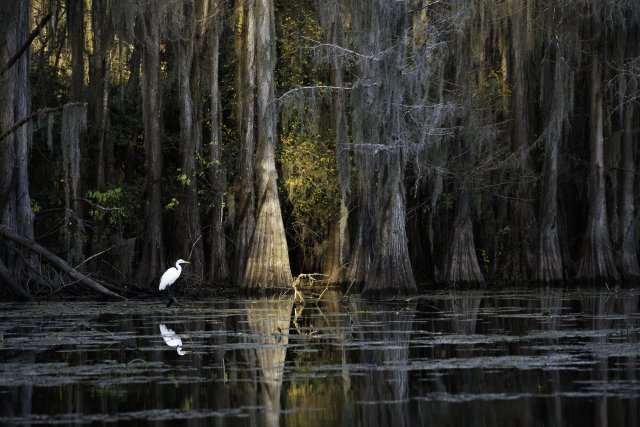Climate Change Connections: Louisiana (Mississippi River Delta)
Climate change is impacting all regions and sectors of the United States. The State and Regional Climate Change Connections resource highlights climate change connections to culturally, ecologically, or economically important features of each state and territory. The content on this page provides an illustrative example. As climate change will affect each state and territory in diverse ways, this resource only describes a small portion of these risks. For more comprehensive information about regional climate impacts, please visit the Fifth National Climate Assessment and Climate Change Impacts by Sector.
On this page:
Introduction: The Unique Mississippi River Delta

The mighty Mississippi River meets the Gulf of America at the Mississippi River Delta in Louisiana. The Mississippi River Delta region encompasses a sprawling area of coastal wetlands and estuarine marshes.1 The Delta region was formed as the Mississippi River, whose drainage basin includes 31 states representing 41 percent of the contiguous United States, deposited layers of sediment over thousands of years to build up the land.2
The unique geography, geology, and ecology of the Mississippi River Delta region is vital to Louisiana’s culture and economy. The Mississippi River Delta is home to diverse ecosystems, including wetlands, swamps, barrier islands, bayous, and beaches. Nearly half of the state’s population calls the coastal region home,3 living in cities like New Orleans and small communities on barrier islands like Grand Isle. Much of the state’s economy is connected to the coast, through global shipping, fishing, and tourism. The Mississippi River Delta provides many vitally important ecosystem benefits, including storm protection, recreation, fisheries, and water supply.4
Climate Impacts: Multiple Factors Are Accelerating Relative Sea Level Rise in Louisiana
Louisiana’s low elevation, averaging only three feet above sea level in the southeastern region of the state, make the coast particularly vulnerable to the impacts of sea level rise.5 From 1932 to 2016, it is estimated that Louisiana lost nearly 2,000 square miles of land, almost the size of the entire state of Delaware.6 Louisiana is experiencing among the highest rates of land loss in the world. In some parts of Louisiana, the relative sea level rise is nearly four times the global rate.5

There are multiple factors that are contributing to relative sea level rise in coastal Louisiana. A primary factor is sea level rise driven by climate change. Thermal expansion (warmer water expands) and added volume from melting land ice like glaciers are increasing the absolute sea level.7 Simultaneously, as absolute sea levels are rising, parts of Louisiana’s coast are sinking due to the natural process of sediment compaction. The Mississippi River delivered sediments that built land along the Gulf Coast. Over the twentieth century, engineering of the river with levees and dams to manage floods and transportation disrupted sediments from being deposited on the Mississippi River Delta.8 This combination of subsidence, restricted sediment deposition, and climate change driven absolute sea level rise are contributing to major land loss in Louisiana.
Sea Level Rise and Land Loss Are Impacting Communities, Economies, and Ecosystems
Along the coast, as barrier islands and coastal communities are confronted with rising sea levels and rapid land loss, people have been faced with difficult decisions about staying, fortifying, or relocating. Isle de Jean Charles, a small island home to a band of Biloxi-Chitimacha-Choctaw Indians, has lost 98 percent of its land over the past several decades.9 The Tribe was awarded a grant from the U.S. Department of Housing and Urban Development for resettlement of the community inland. Land loss and subsequent decisions to relocate can have major implications for community ties, livelihoods, traditional food systems, cultural history, mental health, and spiritual connections with the land. These coastal losses have repercussions for many diverse peoples and cultures that depend on that land and contribute to Louisiana’s unique cultural heritage, especially Creole and Cajun communities. Sea level rise impacts are not experienced equally in Louisiana and across the Southeast, and vulnerable communities in flood risk-prone areas often have fewer resources for preparation, recovery, and relocation.10,11

Climate change impacts are threatening the health of Louisiana’s important wetlands. Louisiana’s coastal wetlands serve as nurseries for a variety of species and play an important role in supporting the state’s commercial fisheries for shrimp, crabs, oysters, and crawfish. Louisiana produces roughly 30 percent of total fishery output in the United States along with significant amounts of shrimp and oysters, which annually contributes billions of dollars to the economy.12 Warming water temperatures can undermine healthy wetlands and coastal waters by promoting harmful algal blooms and contributing to lower dissolved oxygen levels.13 These types of conditions can kill off commercially, ecologically, and culturally important seafood and wildlife.13 Harmful algal blooms can also produce toxins that accumulate in fish and shellfish, rendering them unsafe for humans to eat. Thriving wetlands also play an important role in protecting against storm surge during tropical storms and hurricanes. Losing wetlands increases the damage from such storms.14
Beyond land loss, sea level rise can impact water quality through saltwater intrusion, which is the advance of saltwater into freshwater environments.15 In many places, saltwater intrusion can have serious impacts when salty or brackish water contaminates groundwater or freshwater aquifers. In September 2023, Louisiana faced an acute saltwater intrusion challenge when upstream drought conditions resulted in low water levels in the Mississippi River.16 The reduced streamflow created conditions for saltwater to migrate upriver, which threatened local water supplies. As climate change is expected to bring more frequent droughts and continued sea level rise, the challenges from saltwater infiltration increase.
Taking Action: Living with a Changing Coastline
Addressing climate change requires reducing greenhouse gas emissions while preparing for and protecting against current and future climate impacts. Communities, public officials, and individuals in every part of the United States can continue to explore and implement climate adaptation and mitigation measures. In Louisiana, communities and planners are taking steps monitor, prepare, and respond to the profound impacts of climate change on the coast, including:

- Restoration of wetlands. Wetlands provide myriad benefits in the fight against sea level rise, serving as buffers for flooding and storm surge.17 The Coastal Wetlands Planning, Protection and Restoration Act provides funding for local wetland restoration and rehabilitation projects.18 The projects are designed and planned based on local needs and may involve a combination of nature-based and engineered solutions: vegetative planting, barrier island restoration, hydrologic restoration, terracing, shoreline protection, ridge restoration, and freshwater and sediment diversion.18
- Relocation. Land loss and coastal erosion are making some coastal areas uninhabitable. As sea levels rise and coastal challenges accelerate, many more individuals and communities may make the decision to move inland to higher ground, which often comes with many complicated emotional, financial, and logistical considerations.
To learn more about climate change impacts in Louisiana and the Southeast region, see Chapter 22 of the Fifth National Climate Assessment.
Related Resources
- EPA Climate Change Indicators: Sea Level
- EPA Climate Change Indicators: Coastal Flooding
- Louisiana State Climate Summary 2022 (NOAA)
- Fifth National Climate Assessment: Chapter 9: Coastal Effects (U.S. Global Change Research Program)
- Louisiana Coastal Master Plan
- Our Land and Water: A Regional Approach to Adaptation (LA SAFE)
References
1 Coastal Wetlands Planning, Protection and Restoration Act. (n.d.). The Mississippi River Delta Basin. Retrieved December 28, 2023, from https://lacoast.gov/new/about/basin_data/mr/default.aspx
2 EPA. (2025). The Mississippi/Atchafalaya River Basin (MARB). Mississippi River/Gulf of America Hypoxia Task Force. Retrieved February 5, 2025, from https://www.epa.gov/ms-htf/mississippiatchafalaya-river-basin-marb
3 NOAA Office for Coastal Management. (2024). Louisiana: Coastal management. Retrieved June 11, 2024, from https://coast.noaa.gov/states/louisiana.html
4 Batker, D., de Torre, I., Costanza, R., Swedeen, P., & Day, J. W. (2010). Gaining ground: Wetlands, hurricanes and the economy: The value of restoring the Mississippi River delta (Earth Economics Project Report) [Technical Report]. https://pdxscholar.library.pdx.edu/iss_pub/39/
5 Frankson, R., Kunkel, K. E., Champion, S. M., & Nielsen-Gammon, J. (2022). Louisiana state climate summary 2022 (NOAA Technical Report NESDIS 150-LA). NOAA National Environmental Satellite, Data, and Information Service. https://statesummaries.ncics.org/chapter/la/
6 Couvillion, B. R., Beck, H., Schoolmaster, D., & Fischer, M. (2017). Land area change in coastal Louisiana (1932 to 2016). In Scientific Investigations Map (Scientific Investigations Map 3381). U.S. Geological Survey. https://doi.org/10.3133/sim3381
7 Marvel, K., Su, W., Delgado, R., Aarons, S., Chatterjee, A., Garcia, M. E., Hausfather, Z., Hayhoe, K., Hence, D. A., Jewett, E. B., Robel, A., Singh, D., Tripati, A., & Vose, R. S. (2023). Ch. 2. Climate trends. In A. R. Crimmins, C. W. Avery, D. R. Easterling, K. E. Kunkel, B. C. Stewart, & T. K. Maycock (Eds.), Fifth National Climate Assessment. U.S. Global Change Research Program. https://doi.org/10.7930/NCA5.2023.CH2
8 Alexander, J. S., Wilson, R. C., & Green, W. R. (2012). A brief history and summary of the effects of river engineering and dams on the Mississippi River system and delta (Circular 1375). U.S. Geological Survey. https://pubs.usgs.gov/circ/1375/
9 U.S. Geological Survey. (n.d.). Isle de Jean Charles, Louisiana, USA. Earth Resources Observation and Science (EROS) Center – Earthshots. Retrieved February 22, 2024, from https://eros.usgs.gov/earthshots/isle-de-jean-charles-louisiana-usa
10 Louisiana’s Strategic Adaptations for Future Environments. (2019). Our land and water: A regional approach to adaptation. https://s3.amazonaws.com/lasafe/Final+Adaptation+Strategies/Regional+Adaptation+Strategy.pdf
11 Hoffman, J.S., S.G. McNulty, C. Brown, K.D. Dello, P.N. Knox, A. Lascurain, C. Mickalonis, G.T. Mitchum, L. Rivers III, M. Schaefer, G.P. Smith, J.S. Camp, and K.M. Wood, 2023: Ch. 22. Southeast. In: Fifth National Climate Assessment. Crimmins, A.R., C.W. Avery, D.R. Easterling, K.E. Kunkel, B.C. Stewart, and T.K. Maycock, Eds. U.S. Global Change Research Program, Washington, DC, USA. https://doi.org/10.7930/NCA5.2023.CH22
12 NOAA Fisheries. (2022). Conducting large-scale wetland restoration in louisiana. Retrieved December 28, 2023, from https://www.fisheries.noaa.gov/national/habitat-conservation/conducting-large-scale-wetland-restoration-louisiana
13 EPA. (2024). Climate change and freshwater harmful algal blooms. Harmful Algal Blooms (HABs) in Water Bodies. Retrieved December 28, 2023, from https://www.epa.gov/nutrientpollution/climate-change-and-harmful-algal-blooms
14 Barbier, E. B., Georgiou, I. Y., Enchelmeyer, B., & Reed, D. J. (2013). The value of wetlands in protecting Southeast Louisiana from hurricane storm surges. PLoS ONE, 8(3), e58715. https://doi.org/10.1371/journal.pone.0058715
15 Payton, E. A., Pinson, A. O., Asefa, T., Condon, L. E., Dupigny-Giroux, L.-A. L., Harding, B. L., Kiang, J., Lee, D. H., McAfee, S. A., Pflug, J. M., Rangwala, I., Tanana, H. J., & Wright, D. B. (2023). Ch. 4. Water. In A. R. Crimmins, C. W. Avery, D. R. Easterling, K. E. Kunkel, B. C. Stewart, & T. K. Maycock (Eds.), Fifth National Climate Assessment. U.S. Global Change Research Program. https://doi.org/10.7930/NCA5.2023.CH4
16 Miller, P. W., & Hiatt, M. (2024). Hydrometeorological drivers of the 2023 Louisiana water crisis. Geophysical Research Letters, 51(10), e2024GL108545. https://doi.org/10.1029/2024GL108545
17 EPA. (2023). Basic information about wetland restoration and protection. Wetlands. Retrieved December 28, 2023, from https://www.epa.gov/wetlands/basic-information-about-wetland-restoration-and-protection
18 Coastal Wetlands Planning, Protection and Restoration Act. (n.d.). About us. Retrieved December 28, 2023, from https://lacoast.gov/new/about/

